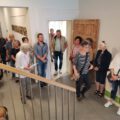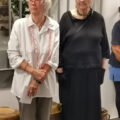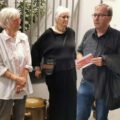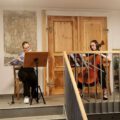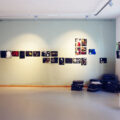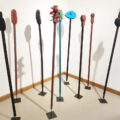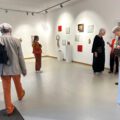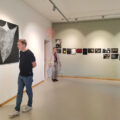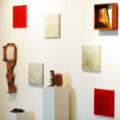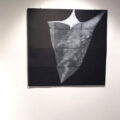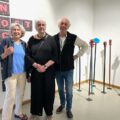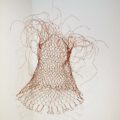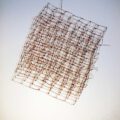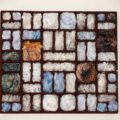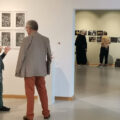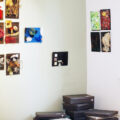Exhibitions
LEICHT – FEST
A Game of Contrasts
2024
altelierhof werenzhain
Doberlug-Kirchhain
Ute Wennrich
Helga Wagner
To talk about one’s own works as an artist isn’t really that easy, but I’ll give it a try.
LIGHT – heavy
SOLID – liquid
Are these merely opposites? Or are they rather descriptions of material states to help us recognize and classify, which makes it possible to place them in a rating system?
Often one of these aggregate states is a precondition for the other to happen or both states are even combined in the same material.
The two materials, copper wire and glass, on which the focus of the exhibition mainly lies, prove to be good examples.
Both materials occur naturally, are hard and heavy, require an immense amount of energy when being processed, they melt and then turn solid again after cooling.
Copper production, for example, requires an elaborate and complex process, in which, unfortunately, pollutants are often set free in the environment.
Glass is made from liquidised soil. Obsidian is a naturally occurring glass of volcanic origin. The base substances for glass are silicates which, when molten, together with additives, undergo a crystallisation process during cooling. The colouring of glass is achieved by adding various metal salts. These metals are substances that can also be found in the soil.
The title 'LIGHT – SOLID A Game of Contrasts' is therefore symptomatic for our exhibition: Helga Wagner’s very light, transparent, floating copper wire works are placed in opposition to the more solid glass works by Ute Wennrich. At the same time, these contrasts are only of a superficial nature, because copper wire, in spite of its flexibility, has a firmness that increases the greater the diameter is, whereas transparency and luminosity are also inherent qualities of the hard and brittle material glass. But it is exactly this ambivalence that fascinates and challenges us to deal experimentally with such materials.
In a conversation with Ferdinand von Schierach, Anselm Kiefer says that he actually plays all the time, and has done so since his childhood in the ruins of the post-war era.
An essential characteristic of playing is curiosity, openness to new things and trying out different possibilities, which also includes failing and scrapping the results.
I think playing and experimenting are also an important starting point for the way we work. That's why I call the individual assemblages of 'The Archive of Remnants' attempts, because there are always several possibilities. Furthermore, these attempts tell stories that are linked to my past and my artistic engagement with our living environment.
This playful approach is also evident in Helga Wagner's works of packages. To do this, she uses packaging material and aids, some of which she created when working in a different context by using her special working method. They combine to form a very airy installation 'Airmail' on the wall in the 1st room. As she says herself: "Packaging becomes art, art is packaging."
Both works – 'Airmail' and 'The Archive of the Remnants' in the 2nd room – use leftovers and recycle them into something completely different, completely new. In this way, both installations enter into a dialogue, although their individual parts could not be more different.
Helga Wagner describes many of the wire objects as spatial drawings or even as thinking with wire, in which light and shadow are an important component of their existence. They are (I quote) "signs and drawings made of copper wire, they stick out from the wall into the room, float from the ceiling, stand sculpturally on pedestals, they change with the light and the viewer’s change of perspective."
Light also plays a prominent role in Ute Wennrich's glass works. Different lighting situations change the colour of the wall relief 'LOST INNOCENCE' or the 9-part figure group 'Guardians of My Egos'.
With this group of characters, the question of different identities is playfully explored: 'Guardians of My EGOs' – A game of the different personalities as a reality or even: Me, an illusion?
Which finally brings us back to playing again:
As beholders of the “work creation”, as Hans-Georg Gadamer puts it, you also act as players in this interaction.
He says in his essay 'The Actuality of the Beautiful':
“… The introduction of the concept of playing had precisely the point to show that everyone is a player in a game. This should also apply to the game of art, where there is principally no separation between the actual work of art and those who experience it ...”
With this in mind, we are happy to accompany you on your walk through the exhibition and look forward to talking to you, because there is certainly much more to discover than what is mentioned here.
Last not least, a special thanks to Iris Stöber and her team, who made the exhibition possible for us and actively, supported us in setting it up.
Ute Wennrich, translation: Hanne Schestak

